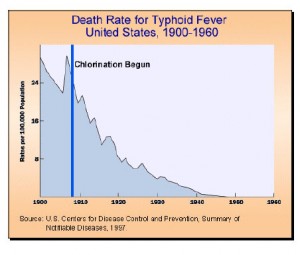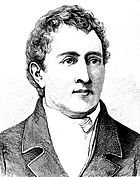The Pure Water Occasional for October 14, 2013
With articles about how the government shutdown affects the EPA (and, consequently, all of us), the strange world of regulatory politics as seen in the hexavalent chromium battle, and Pure Water Annie on the history of chlorination. There is also lots of world water news, and, as always, much more.
What Happens When The Government Shuts Down 94 Percent of the EPA
To start, 94 percent of the Environmental Protection Agency’s 16,000 workers were furloughed due to the government shutdown.
Over 15,000 EPA employees are now sitting at home. Consider what the EPA does. The EPA monitors air quality, regulates pesticides and waste, cleans up hazardous chemical spills, and ensures that people have safe drinking water, among other things. Now, according to the plan it laid out for the shutdown, only some workers will be on hand to respond to emergencies and to monitor labs and property.
That means the EPA will temporarily halt cleanup at 507 superfund sites across the country. Sites where the EPA was cleaning up hazardous chemicals are shuttered in any situation where closing them down won’t be an immediate threat to the surroundings. This will slow down cleanups and tack on additional costs that will accrue as these contaminated sites are left to their own devices, says Scott Slesinger, legislative director at the National Resources Defense Council and a former EPA employee. “The only sites that would be exempted would be those that, if they stopped working tomorrow, contaminants will immediately get into the drinking water,” Slesinger says.
Rules and regulations that the EPA usually makes could be delayed, too. But President Obama’s recent proposal for stricter regulations for power plants could stay on track.
Other government activities related to the environment will be affected as well, such as areas that have experienced recent natural disasters. FEMA, which is part of the Department of Homeland Security, will reduce the number of people sent to help with flood recovery in Colorado, but the agency says it won’t cause any setbacks to recovery efforts. Superstorm Sandy recovery efforts are also expected to continue. Work stabilizing and repairing Yosemite National Park and the surrounding Stanislaus National Forest, which were hit by a devastating wildfire last August that is still not completely contained, will continue, though the firefighters who remain on the job could become strained for the resources they need.
“Most of the time no one is watching most of the water for most of the contaminants.”
by Hardly Waite
Published originally in the Pure Water Occasional for December, 2010. Since that time, the regulatory controversy over hexavalent chromium goes on. For an update, see this current article by Erin Brockovich.
In late 2010 an environmental group revealed that deadly hexavalent chromium is present in the water of many US cities. Americans were shocked.
Actually, what’s new with the hexavalent chromium issue isn’t that Chromium-6 has suddenly been spilled into US water supplies. What’s new is that someone told us about it.
Chromium-6 is only one of countless chemical contaminants that find their way into water but don’t get much public attention. In the 1980s I read a perceptive article on the subject that said, “Most of the time no one is watching most of the water for most of the contaminants.” In 2010 there’s a lot more to watch for, since new chemicals are being created almost faster than we can give them names, yet we continue not watching.
News about water quality comes and goes in the public mind. Ralph Nader made shocking revelations about water quality in the 1980s, but people soon forgot. The public has a short attention span.
Chromium-6 didn’t just appear suddenly in the water supplies of 31 of the 35 cities examined. It has been there a long time. The news is that someone went to the trouble to look for it and report it. Actually, it had been looked at earlier by government agencies, but they were happy to keep its presence to themselves as long as no one brought the subject up. This isn’t an uncommon event. Just this month the FDA revealed (after much prodding) that US agribusiness now drugs farm animals with 29 million pounds of antibiotics per year. Most people are aware that factory farm animals are being dosed with antibiotics and that consequently antibiotics are becoming ineffective, but the 29 million pound number is somewhat sobering. (A “shitload,” Grist calls it.) Does anyone doubt that a few tons of these drugs make their way into water supplies?
Chromium is present in water as trivalent and hexavalent chromium. The problem is that trivalent chromium is not only harmless but is an essential human nutrient. Hexavalent chromium is a potent poison. The state of California, which is usually about 20 years ahead of the rest of the country in environmental regulation, is proposing a maximum allowable of 0.06 parts per billion hexavalent chromium. The EPA is currently monitoring total chromium with a maximum allowable of 100 parts per billion.
Here is the EPA’s statement on chromium, which was issued after it received criticism for dragging its feet on the regulation of chromium-6:
“EPA absolutely has a drinking water standard for total chromium, which includes chromium-6 (also known as Hexavalent Chromium), and we require water systems to test for it. This standard is based on the best available science and is enforceable by law. Ensuring safe drinking water for all Americans is a top priority for EPA. The agency regularly re-evaluates drinking water standards and, based on new science on chromium-6, had already begun a rigorous and comprehensive review of its health effects. In September, we released a draft of that scientific review for public comment. When this human health assessment is finalized in 2011, EPA will carefully review the conclusions and consider all relevant information, including the Environmental Working Group’s study, to determine if a new standard needs to be set.
Background:
Currently, the total chromium standard is 0.1 mg/L (100 parts per billion). Our latest data shows no U.S. utilities are in violation of the standard.”
Now, to give an idea of how close to agreement are the two expert views—the California standard vs. the EPA standard—notice first that the EPA is measuring “total chromium” and California is measuring only chromium-6. Note, too, in case you haven’t, that the allowable numbers are not even in the same galaxy.
To sort all this out, image that, since we know that our potato chip intake should probably be limited, you consult a nutritional expert to find out how many bags of potato chips you can safely eat each month. His answer is one. You then consult a second expert whose answer is that you can safely eat a combined total of 1667 bags of potato chips and apples. The experts then take a survey of Americans’ eating habits. Expert #1 finds that 31 in 35 are violating the one bag per month standard for potato chip consumption, but expert #2 concludes that all is well because “no Americans are violating the combined potato chip and apple standard” by eating 1667 per month. By standard 2 you can safely eat 55 bags of potato chips (and no apples) per day.
That’s no more absurd than the advice we’re getting from the combined wisdom of California regulators and the EPA. The numbers are radically different and they’re counting different things.
![700ways320[1]](https://ymlp.com/https.php?id=purewatergazette.net/blog/wp-content/uploads/2012/05/700ways3201-300x234.jpg)
The official allowable for chromium-6 will, after months or years of negotiation, eventually be set most likely somewhere between the extremes of 0.06 ppb and 100 ppb. The number will not be arrived at scientifically but will result from a political negotiation that considers the interests of manufacturers and sellers of products that use chromium, city water departments, environmental advocacy groups, wastewater processors, and a host of politicians who represent the interests of a host of lobbyists who are being paid by everyone from mining companies to state governments. Each of these non-expert entities will employ its own set of experts who will rely mainly on the mysterious “science” of animal studies to prove its point. Animal studies, a science of roughly the same exactitude as having soothsayers examine the intestines of sacrificed goats, will conveniently prove what each of the interested parties wants proved. The final magic number, the amount of chromium-6 we can safely be exposed to, will depend mainly on the number of Republicans vs. Democrats on the committee.
World Water News
When we looked through these articles for good news the best we could find is a story about how Maryland’s Department of the Environment has issued an order to temporarily stop the dumping of sludge into a gravel pit. This week even the girl’s water polo scores were depressing, so I didn’t include them. –Hardly Waite.
Water: All dried up. Northern China is running out of water – but the government’s remedies are potentially disastrous.
Furloughed US inspectors leave gaps in safety oversight. The partial shutdown of the U.S. government has sidelined thousands of inspectors who monitor everything from air and water pollution to safety hazards at factories and the condition of nursing homes.
What ever happened to the deal to save the Everglades? Five years ago, Florida officials announced a deal many believed would do just that. It was a plan to buy nearly 300 square miles of Everglades land owned by U.S. Sugar. But then, reality set in: The economy worsened and political opposition grew, forcing state officials to settle for a much smaller parcel.
Another blunder at Fukushima as worker removes water pipe, exposing six people to radiation. Six workers at Japan’s Fukushima nuclear plant have been exposed to radiation after an employee accidentally removed a pipe connected to a water treatment system, causing around 10 tonnes of toxic water to escape, Tokyo Electric Power Company said.
Haiti cholera outbreak victims sue UN peacekeepers. Victims of the 2010 cholera outbreak in Haiti are suing the United Nations for billions of dollars in damages over claims it was triggered when sewage from infected peacekeepers was discharged into the water system.
Wyoming officials call for timeout on missile silo cleanup. The U.S. Army Corps of Engineers will honor a state request to temporarily halt the cleanup of groundwater contamination at an abandoned Atlas missile site west of Cheyenne.
Algal blooms causing concern in northern lakes. For years Lake Erie has been the poster child in the Great Lakes for the problem of toxic algae. More recently, though, the problem has been showing up farther north around Lake Michigan. The reason, for some? Corn.
Maryland stops sewage sludge in gravel pit. The Maryland Department of the Environment has issued a temporary stop work order on the application of sewage sludge at an active sand and gravel mining site near Malcolm Elementary School in Waldorf following complaints from nearby residents of unbearable smells and rampant flies throughout the community.
Protecting lives the top priority for chromium-6. In 2001 our legislators mandated that the California Department of Public Health complete by January 2004 an enforceable drinking water standard for the cancer-causing chemical hexavalent chromium – a limit on the amount that this industrial contaminant would be allowed in drinking water. The featured article is by Erin Brockovich. Also, see Hardly Waite’s article above.
UK: Did vandals cause River Crane devastation? The River Crane pollution that killed thousands of fish came from a damaged pipe leaking sewage sludge, Thames Water confirmed. Nature-lovers were shocked to discover the river poisoned on Friday morning, almost two years after a pollution incident nearly destroyed the Crane’s ecosystem.
31 in Fla. infected by bacteria in salt water. State health department officials say 31 people across Floridahave been infected this year by a potentially deadly, yet common bacteria that lives in salt water — and 10 of those people have died.
Chlorination of Water–History and Practice
by Pure Water Annie
A new instalment in Gazette Technical Writer Pure Water Annie’s Water Treatment 101 Series
Not all micro-organisms found in water are harmful to human health. In fact, most are not. There are, however, disease-causing micro-organisms that we have learned to protect ourselves against. These are called pathogens.
Pathogens in raw water from rivers, lakes and wells can be transmitted to humans who consume the water causing waterborne diseases. Today some 80% of the developing world’s illness can be attributed to waterborne pathogens and poor sanitation.
Various strategies have been used to combat waterborne illness. In our time, the most popular of these is chlorination. Chlorine has been in use for over a century and has been found to have drawbacks; it is, however, still first choice for disinfection of water supplies. We should keep in mind that nothing lasts forever; bloodletting was the physician’s main treatment strategy just a few decades ago, and now doctors have given up their bleeding tools and leaches. Chlorine won’t be around forever, but it has served us well.
At the time when chlorine was discovered in Sweden in 1744, scientists believed that odors from water were responsible for transmitting diseases. In 1835, chlorine was being used to remove odors from water, but it wasn’t until the 1890s that people began to really comprehend that chlorine was an effective tool for disinfecting water and thus preventing waterborne disease.
![occasionalbanner300[1]](https://ymlp.com/https.php?id=purewatergazette.net/blog/wp-content/uploads/2013/04/occasionalbanner3001.gif)



